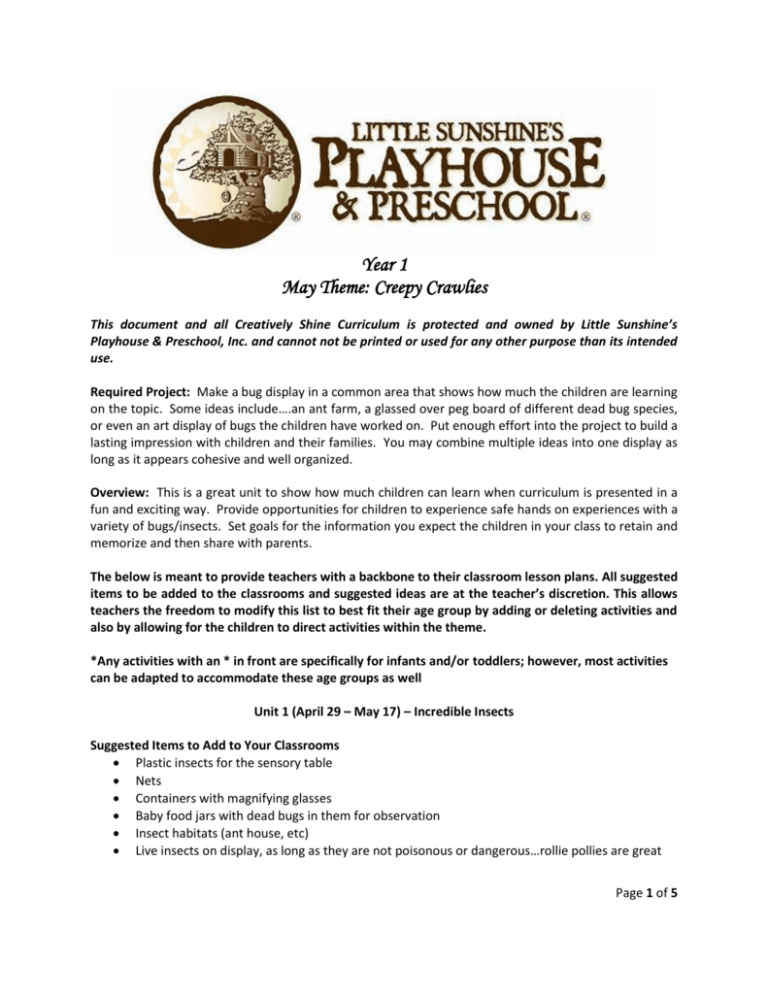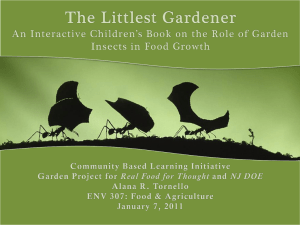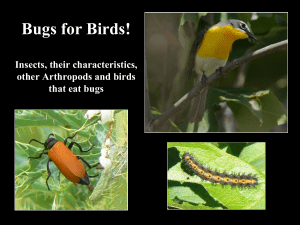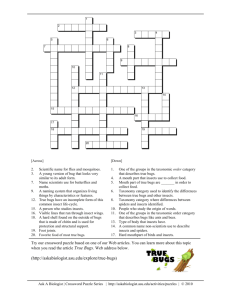Year 1 May Theme: Creepy Crawlies
advertisement

Year 1 May Theme: Creepy Crawlies This document and all Creatively Shine Curriculum is protected and owned by Little Sunshine’s Playhouse & Preschool, Inc. and cannot not be printed or used for any other purpose than its intended use. Required Project: Make a bug display in a common area that shows how much the children are learning on the topic. Some ideas include….an ant farm, a glassed over peg board of different dead bug species, or even an art display of bugs the children have worked on. Put enough effort into the project to build a lasting impression with children and their families. You may combine multiple ideas into one display as long as it appears cohesive and well organized. Overview: This is a great unit to show how much children can learn when curriculum is presented in a fun and exciting way. Provide opportunities for children to experience safe hands on experiences with a variety of bugs/insects. Set goals for the information you expect the children in your class to retain and memorize and then share with parents. The below is meant to provide teachers with a backbone to their classroom lesson plans. All suggested items to be added to the classrooms and suggested ideas are at the teacher’s discretion. This allows teachers the freedom to modify this list to best fit their age group by adding or deleting activities and also by allowing for the children to direct activities within the theme. *Any activities with an * in front are specifically for infants and/or toddlers; however, most activities can be adapted to accommodate these age groups as well Unit 1 (April 29 – May 17) – Incredible Insects Suggested Items to Add to Your Classrooms Plastic insects for the sensory table Nets Containers with magnifying glasses Baby food jars with dead bugs in them for observation Insect habitats (ant house, etc) Live insects on display, as long as they are not poisonous or dangerous…rollie pollies are great Page 1 of 5 Suggested Ideas for Focus on the "Whole Child" Social/Emotional Sing “The Ants Go Marching One by One”. Hold up the numbers as you sing them. Go exploring for bugs. Have bug catchers ready for what you find. Look under rocks and in your nature center area. Get stick bugs at a local pet store and put on display in your science area. Let children hold the bugs or just observe. Do a dancing bugs science project. Fill a glass with sprite and drop raisins in and watch them dance up and down. Do a firefly dance. Turn the lights out and give each child a small flashlight. Physical (fine and gross motor) Make a number book of insects. Put the correct number of insects on each page. Be sure to use a variety of insects. Let children assemble. Make an ant farm (real or drawing.) Show the underground burrows. If you choose to make a drawing, Velcro the ants on so the children can move them around in the tunnels. You could also make a small version for each child. Make bug eyes and have your cameras ready! Cut out two sections of an egg carton. Punch a hole on each end for a string to be attached to make a mask. Let the children paint and decorate any way they like. Who eats insects? Read a story about a frog that zaps an insect with his tongue. Get party blowers and attach Velcro to the end. Then laminate some insects like dragonflies, flies, butterflies. Add the other piece of the Velcro to the insects. Let children pretend to be frogs eating insects. *Plastic bug clear shaker bottle – allow the children to experiment with it by shaking and rolling it Cognitive Order lady bug larvae so children can watch the larvae turn into adult lady bugs. Make a set of lady bug number matching cards. Whatever number you have on the card give the ladybug that number of black spots. Laminate these cards so they can be used continuously. You can also make a set for each child to take home. Teach colors and directional positions by using an ant or another insect of your choice. Make a display that shows the ants in different places. Have the children color the ant on top of the house green. Color the one under the rock yellow and so on. Discuss opposites that different insects have. Wings/no wings. Hard shell/soft shell. Have children match insect with their home. Bee/hive. Ant hill/ant. Make fingerprint bugs. Take this opportunity to tell each child they are special because no two fingerprints are alike. Teach that insects have three body parts (head, thorax, and abdomen) and six legs plus antennae. Make sure children understand that worms, spiders, etc. do not fall into this group. Practice identifying creatures that are and are not insects. *Have the children squeeze plastic/rubber bugs of different textures (smooth, bumpy, squishy, hard, etc.) and verbalize to them how they feel (Example: “Oh, that bug is squishy!”) Language/Communication Page 2 of 5 Read The Grouchy Lady Bug. Have the children paint the silver lids from frozen juice containers red. When they dry, have them glue on black spots, legs and antenna. Put a small magnet on the back so they can take it home and put it on their refrigerator. Talk about feelings. Is their lady bug grouchy or nice, mad or sad? Make a word family wheel so the children can practice rhyming. Put up the letters “ug.” On the wheel have letters that rhyme with bug. You could use the following letters b, r, m, j. t, and then one or two that wouldn’t work. Trace the words you made on the rhyming wheel. Ask pre-K class if anyone can write one of the words on the white board all by themselves. Teach 3-5 bug words in sign and second language. Sing “Baby Bumblebee” and act it out. Workbook Curriculum Workbook curriculum should be carried out daily in each classroom with (children over the age of 12 months) for 10-20 minutes, depending on age. At this time we are not mandating what brand or type of workbook. Workbooks should teach general cognitive principals for the child’s age (colors, shapes, tracing, recognition, memorization, numbers, and alphabet). The activity should be in paper form and available for parents to review at least weekly. This addition to our curriculum is a supplement needed to meet the expectations of families and further prepare children for Kindergarten. Workbook curriculum is not considered a creative art experience; it is merely a supplement to encourage cognitive growth. Unit 2 (May 20 – 31) – Bugs (not insects) Suggested Items to Add to Your Classrooms Cup of real worms Pretend or real butterflies Bug house or jar Bug vision goggles Magnifying glass Suggested Ideas for Focus on the "Whole Child" Social/Emotional Teach the children the actions to “The Itsy, Bitsy Spider.” Have children pretend to be caterpillars by crawling around. Then tell them it is time to form a cocoon. Give them a blanket to wrap up in. Now tell them they are a beautiful butterfly and let them fly around. Sing the song “Herman the Worm” and do the actions. Make up a progressive story about a praying mantes and a butterfly. Take turns having the children act it out. Tell about their lives and how they became friends. Have a picnic and feed the critters that like to invade a picnic. Put plastic worms in a plastic container filled with water and have children try to retrieve them with their toes. No hands allowed. This would be a good time to talk about handicaps, like what would you do without your hands? What are all the things we use our hands for? For smaller children you might want to let them catch the worms with a small net and count how many they get. Page 3 of 5 *Bug/worm crawl and chase tag Physical Put a black piece of paper inside a 13 by 9 pan. Put a marble covered in white paint in the pan and let the child move the pan so the marble rolls around to make a spiders web or the trail of a worm. You can add white sparkles to the paint to make it glisten. Glue on a black plastic spider or a worm when it dries or make one out of black construction paper. Spider prints are fun, too. Take plastic spiders and let children dip in black paint and make prints on white paper. Make your own worm farm for the children to explore. In a large plastic tub put dirt and earth worms. Add a few rocks and leaves. Purchase some worms from a bait store and add to the container. Put a box of plastic gloves out for children to get a real hands on experience of what it feels like to pick up a worm. Teach some worm facts.(5 hearts, no bones, no lungs, etc.) Have children make centipedes with all those feet. Or make a large one for the classroom and have children make different shoes for its feet. Practice counting and colors. Trace each child’s shoes to make wings for their butterfly. Cognitive Use butterfly metamorphosis kits to show the children the process of metamorphosis. The children will check this every day. Compare and contrast the body parts of an insect to an arachnid. (2 body parts/3 body parts; 6 legs/8 legs) Worms are our friends. They turn the soil and make things grow. They help the farmer grow our food. Teach these facts at circle time. And encourage children to share what they have learned with their parents. Make a matching game of different kinds of butterflies or spiders. Or use all insects from this unit and have the children find the two that match. Show children what can happen when grasshoppers invades crops and eat all the plants. This was before pesticides became available to tell grasshoppers to go elsewhere to find their food. Categorize different types of bugs on charts Language/Communication Diagram the parts of a spider. Teach the children “Little Miss Muffet.” Make finger puppets of little “Miss Muffet” and the spider. Read The Very Quiet Cricket and discuss how they make their sound. You can get some crickets for your classroom from a pet store or bait shop. Write a poem with the children helping by supplying you with words that rhyme. Teach a song or finger play in sign language. Workbook Curriculum Workbook curriculum should be carried out daily in each classroom with (children over the age of 12 months) for 10-20 minutes, depending on age. At this time we are not mandating what brand or type of workbook. Workbooks should teach general cognitive principals for the child’s age (colors, shapes, tracing, recognition, memorization, numbers, and alphabet). The activity should be in paper form and available for parents to review at least weekly. This addition to our Page 4 of 5 curriculum is a supplement needed to meet the expectations of families and further prepare children for Kindergarten. Workbook curriculum is not considered a creative art experience; it is merely a supplement to encourage cognitive growth. Page 5 of 5






